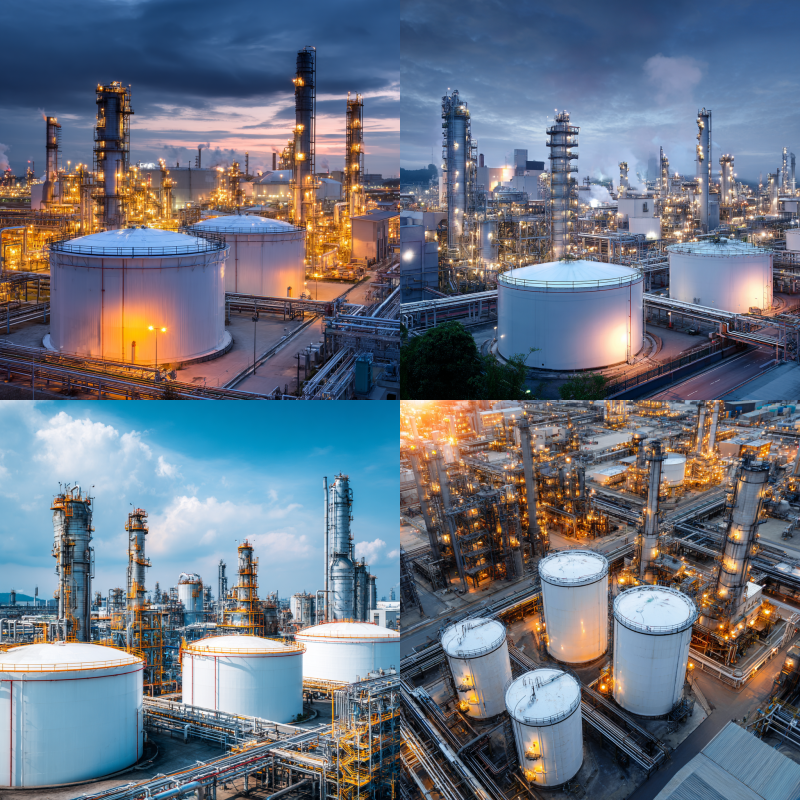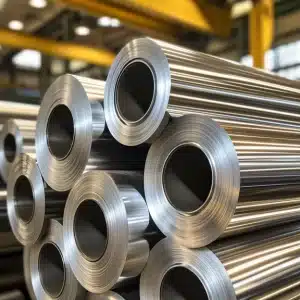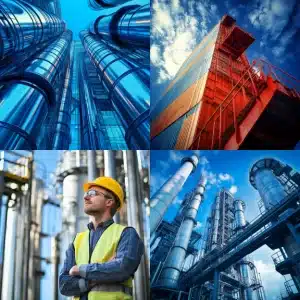
Unlocking What Are the Different Types of Pressure Vessels?
What are the different types of pressure vessels?
If you have ever wondered, “What are the different types of pressure vessels?” you are in the right place. Pressure vessels are specialized containers designed to hold gases or liquids at a pressure significantly different from the surrounding atmosphere. They play a vital role in industries such as petrochemicals, pharmaceuticals, and aerospace. A 2024 study highlighted that these vessels are used in over 60% of manufacturing processes worldwide (Baker Industries). Sounds huge, right? Good news, understanding these vessels is easier than you might think.
Explore what are the different types of pressure vessels
When you decide to invest in a pressure vessel, it helps to know the primary categories. Each type is defined by its purpose, whether storing gases, facilitating heat transfer, or driving chemical reactions. According to Forged Components, the following are some widely recognized types you will encounter:
Storage vessels
- These are the most common type of pressure vessels, storing substances such as petroleum products, chemicals, compressed air, or water.
- They handle high internal pressures so the contents remain stable, safe, and ready for use.
- If you want to dive deeper into how pressurized storage differs from more standard tanks, check out what is the difference between a pressure vessel and a tank.
Heat exchangers
- Heat exchangers transfer heat from one medium to another without mixing them.
- They are common in HVAC systems, chemical plants, and refineries to either remove waste heat or facilitate chemical reactions.
- According to TSA Process Equipments, heat exchangers manage temperature with impressive efficiency, helping you control process conditions smoothly.
Process vessels
- Process vessels oversee essential transformations such as chemical reactions.
- They can combine products, break them down, or catalyze new compounds altogether (Forged Components).
- This category includes reactors, fractionation columns, and other specialized vessels that work under high pressure and temperature.
Fractional distillation vessels
- These vessels separate mixtures based on boiling points.
- By heating a mixture until one component vaporizes, you can split different substances into purer forms.
- If you (or your facility) regularly handle multi-component fluids, fractional distillation is a reliable way to get precise separation.
Pressure reactors
- Pressure reactors are specialized vessels used for reactions that need temperatures above a solvent’s normal boiling point (Forged Components).
- They help produce chemicals or pharmaceuticals more quickly by speeding up the reaction.
- Reactors are common in petroleum refining, biochemical, and pharmaceutical industries.
If you would like a quick refresher on why these containers must handle pressure so diligently, you can check out what is a pressure vessel. You will find helpful context on the core differences between these vessels and ordinary containers.
Examine vessel shapes
Just as their purposes differ, so do the shapes of pressure vessels. You will often see cylindrical, spherical, or conical designs, each with its own advantages:
Cylindrical vessels
- By far the most prevalent shape (Wermac), especially for storing liquids at moderate pressures.
- They have “weak” points on each end if not designed and reinforced properly. Using rounded or hemispherical heads helps distribute stress evenly.
- Cylindrical vessels are cost-effective and commonly used in manufacturing because they are simpler to fabricate than spherical vessels.
Spherical vessels
- These can sustain extremely high internal pressures since stress is evenly distributed across the surface.
- Spherical designs tend to be more expensive to build but are excellent in scenarios demanding the highest strength.
- Often found storing liquefied gases like propane or ammonia.
Conical or torispherical designs
- Conical sections are sometimes integrated into cylindrical vessels for smooth flow of materials.
- Torispherical heads, such as Klöpper or Korbbogen heads, maintain a rounded interior surface that reduces stress points (Wermac).
- You will see these shapes in industrial and chemical processing sectors.
Ultimately, your industry demands and specific operating pressures guide which shape is best. For instance, if you are dealing with extremely high pressures, a spherical vessel might outlast and outperform others.
Look at common fabrication materials
Your choice of material is crucial. It directly affects a vessel’s durability, safety, and ultimately your bottom line. According to the PALA Group, top options include:
Stainless steel
- Resists rust, stains, and extreme temperatures.
- Easy to clean, making it a popular choice in pharmaceutical or food-processing applications.
- If you are unsure about the best steel grade for your scenario, you could consult pressure vessel materials or what materials are used in pressure vessels.
Carbon steel
- Strong, cost-effective, and recyclable.
- Withstands shock and vibrations, though it may require protective coating or galvanizing to prevent rust.
- Ideal for many industrial applications where cost and durability must balance.
Nickel alloys
- Alloys like Monel, Inconel, and Hastelloy offer high corrosion resistance.
- Suited for harsh chemical environments, extending a pressure vessel’s lifespan.
- Higher price point but excellent for specialized operations involving aggressive substances.
Titanium
- Provides outstanding corrosion resistance and an impressive range of tensile strength (30,000 psi to 200,000 psi).
- Biocompatible, so you will find it used in medical or specialized chemical applications.
- Higher upfront cost than carbon or stainless steel, but it can be worth it if you need top-tier corrosion protection.
Good news, the variety of metals means you can match a vessel to your unique budget and performance needs. For more insight, you can explore how to choose materials for pressure vessels.
Adhere to vital regulations
When you want to know not just “what are the different types of pressure vessels,” but also how to keep them safe, you will bump into the ASME (American Society of Mechanical Engineers) guidelines. The ASME Boiler and Pressure Vessel Code, particularly Section VIII, is the cornerstone of pressure vessel design, fabrication, and testing in the United States (Baker Industries).
Why ASME guidelines matter
- They became mandatory in the early 1900s to reduce the risk of catastrophic accidents from faulty fabrication (Buckeye Fabricating).
- Compliance ensures your vessel is legal, certified, and safe to operate.
- ASME rules require regular inspections and thorough documentation of design, testing, and material selection, which helps you avoid expensive failures.
Meeting code requirements
- Pressure vessels must undergo pressure tests (hydrostatic or pneumatic) at specified multiples of their Maximum Allowable Working Pressure (MAWP).
- Hydrostatic tests store minimal energy in compressed water, making them safer for high-pressure systems (TotalShield).
- Pneumatic tests can pinpoint extremely fine leaks but carry higher risk due to stored energy in compressed gases. Certified, careful supervision is a must.
If you want more detail on applicable codes, check out pressure vessel codes or what are pressure vessel codes. You could also explore specifics like what is asme pressure vessel code or what are the different types of pressure vessel codes to see exactly how these regulations protect your workplace.
What are the different types of pressure vessels?
You have seen that the term “pressure vessel” covers a wide range of containers, each carefully designed to handle high internal or external pressures. From simple storage units for chemicals and air, to highly complex reactors enabling specialized chemical processes, each vessel type has a critical role in industrial operations. Vessel shapes also vary, with cylindrical and spherical models being the most common, while materials range from affordable carbon steel to premium titanium alloys.
Need a reliable partner?
Red River specializes in the design and manufacturing of pressure vessels. We also fabricate related items such as prefabricated spools and skid packages.
Reach out to us today and experience the Red River difference. Where American-made products and American Values come together, we care more.
Frequently asked questions
1. What is a pressure vessel
A pressure vessel is a closed container designed to hold gases or liquids at pressures significantly different from atmospheric pressure (typically above 15 psi). These engineered vessels feature specific wall thickness, materials, and safety components to prevent failure. Common examples include boilers, air compressor tanks, propane cylinders, and autoclaves. All pressure vessels must comply with safety codes like ASME standards.
2. What are the different types of pressure vessels?
Pressure vessels are classified by:
Shape: Cylindrical (most common), spherical (high-pressure applications), and rectangular
Pressure type: Internal pressure vessels (containing pressurized contents) and external pressure vessels (withstanding vacuum/external pressure)
Application: Storage vessels, heat exchangers, process vessels, and steam boilers
Material: Carbon steel (standard), stainless steel (corrosive environments), and composite materials (lightweight applications)
3. What is the difference between a pressure vessel and a tank?
Pressure vessels operate above atmospheric pressure, require strict engineering codes, specialized safety components, and regular inspections. They’re more expensive due to safety requirements.
Tanks typically operate at atmospheric pressure, have simpler construction, fewer regulations, and lower costs. The key distinction is operating pressure—tanks become pressure vessels when designed for pressurized operation, triggering pressure vessel codes and safety requirements.
4. Why are ASME codes so essential?
The ASME codes reduce the risk of catastrophic accidents. By enforcing design, fabrication, and testing standards, they ensure that any pressure vessel used in the United States meets strict safety criteria (Buckeye Fabricating).
5. Which materials help prevent corrosion in a pressure vessel?
Stainless steel, nickel alloys, and titanium excel at resisting corrosion. If you want maximum corrosion protection, you might look at titanium or Hastelloy, though carbon steel can be coated or galvanized as needed.
Key takeaways
- Confirm the exact role of your pressure vessel: storage, heat exchange, or process (e.g., reactors, fractional distillation).
- Consider shape carefully, since spherical, cylindrical, or torispherical designs affect cost and performance.
- Choose materials based on pressures, temperature ranges, and corrosion requirements, balancing cost and safety.
- Follow ASME standards and schedule regular inspections to avoid unexpected breakdowns and accidents.
- Consult reputable manufacturers and certified fabricators to get a vessel that meets industry-grade requirements.
Related Blog Post

Marine-Grade vs Standard Stainless Steel

Pros and Cons of Vertical Integration

How to Dry Desiccant Properly and Regain Its Effectiveness

Why Do Gas Turbines Need Fuel Water Separator Vessels, Red River

